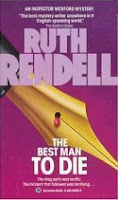 In the late fourteenth century, a band of pilgrims journey toward Canterbury. At the Host’s suggestion, each agrees to tell two tales: one on the road to Canterbury, and one on the way back. The unfinished collection of stories features twenty-four tales (or parts thereof) from twenty-three pilgrims, including the author himself. They range from tedious to bawdy; the Cook’s tale apparently so ribald it had to be left unfinished. Most of the tales are in rhyming couplets; but several are in stanzas and two are works of prose. Incidentally, the two prose stories are the two most moralistic and tiresome; Chaucer and the Parson waxing dull on prudence and penitence respectively.
In the late fourteenth century, a band of pilgrims journey toward Canterbury. At the Host’s suggestion, each agrees to tell two tales: one on the road to Canterbury, and one on the way back. The unfinished collection of stories features twenty-four tales (or parts thereof) from twenty-three pilgrims, including the author himself. They range from tedious to bawdy; the Cook’s tale apparently so ribald it had to be left unfinished. Most of the tales are in rhyming couplets; but several are in stanzas and two are works of prose. Incidentally, the two prose stories are the two most moralistic and tiresome; Chaucer and the Parson waxing dull on prudence and penitence respectively.
The tales are each suited to the character that tells them; risqué tales from the working men, fables and Christian themes from the religious figures, and the story of a knight sent to discover what women want from the Wife of Bath. The most interesting one, from a historical perspective, is the Monk’s Tale, a catalogue in verse of prominent figures come to bad ends. The list includes Bernabò Visconti of Milan, whose murder in 1385 allows a narrowing of the timeframe during which the tales may have been written. Another favourite was the Manciple, who told an Aesop-style legend explaining why crows are black and tone-deaf.
As interesting as the tales themselves are the interspersed sections of Chaucer’s narrative, showing the actions and words of the pilgrims and the Host. This allows the pilgrims to become characters in their own right, and not merely vehicles for relating the tales. The highlight of this is the disagreement between the Friar and the Sompnour, two mediaeval careers that did not get along. The Friar proceeds to tell a tale about a corrupt sompnour being taken by the devil, and the Sompnour retaliates with the story of a foolish friar. Later on the journey, Chaucer’s verse romance satire is interrupted by a dissatisfied audience, and he launches into the allegory of Prudence instead (unfortunately).
Not even the first half of the collection was ever finished; both the Cook’s and Squire’s tales are incomplete, and the Cook is later spoken of by the Host as not having told a story. One can only imagine how the Squire’s tale might have ended; and what the Cook’s tale was that it had to be censored (rather impressive, one would think, if it was bawdier than the infamous Miller’s tale). To a modern reader the readability of the tales varies greatly; but they do offer an extraordinary window into mediaeval English life.
Rating: B























